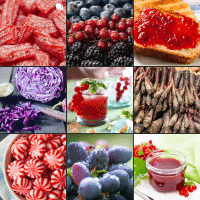Polyphenols are molecules produced naturally by the metabolic processes of plants as a defense barrier against attacks by external pathogens and constitute one of the groups of micronutrients present in the plant kingdom, being an important part of the diet.
These compounds have antioxidant and beneficial properties in health, such as in the treatment and prevention of cancer, cardiovascular disease and other inflammatory pathologies.
There are three major polyphenols.
-
Phenols: They are mainly found in small fruits and in tea.
-
Flavonoids: represent the largest class of polyphenols and are found, for example, in citrus fruits and pomegranates.
-
Tannins: They are found in grapes and other types of fruit.
Without polyphenols, plants and trees could not protect themselves from the external attacks of pathogens and oxidative stress caused, for example, by UV rays. In addition, polyphenols are the molecules responsible for the color of plants. The bright colors of the fruits are an indispensable characteristic of the plants, which make them attractive for both humans and animals, facilitating the dispersion of their seeds and ensuring their reproduction.
As a consequence of their antioxidant action, polyphenols have antithrombotic and anti-inflammatory effects; Besides the vasodilatory properties that favor the control of arterial tone, other properties of flavonoids have been described that also favor their cardioprotective effect.
The antithrombotic effect of polyphenols arises from studies with anthocyanins (a type of natural flavonoid found in most blue, red and purple fruits and vegetables), where it was shown that these compounds are capable of inhibiting platelet function.
Anthocyanins besides being a natural antioxidant, which helps the human body to counteract cell degeneration, are a natural and healthy food dye that appears in products with the code E-163 or also as Coloring Food by the process of obtaining. We can consider them a very complete dye, because it generates the desired color to foods and also brings all the benefits of anthocyanins, although in very small amounts.
So far anthocyanins have been described as red pigments, but in reality they may present other colorations depending on the pH and also on their interrelation with other polyphenols. Anthocyanins therefore have an enormous range of colours.
Within the anthocyanin group we have enocyanine, which is the natural dye of red grapes; is recovered from the shell. The change from red to violet of this dye is an indicator of pH. Enocyanine is listed as one of the food additives with the abbreviation E163 (grape skin extract).
Its use is in the pigmentation of beverages, liqueurs, yogurts, ice cream, etc.
Enocyanine is soluble in water and alcoholic solutions and insoluble in lipid solvents. The stability of the dyes contained in enocyanine is generally very good; the main degradation factors are oxidative, which can lead to a loss of color with the formation of brown pigments. This oxidative degradation is aided by light and storage temperature. In temperatures of less than 10 ° C and in the dark there is no appreciable loss of color for about 6 months.
In INCOLTEC we have a whole world of anthocyanin alternatives that come from raw materials such as radish, black carrot, magenta and grape skin. Contact us for more information at https://incoltec.com/contact/



